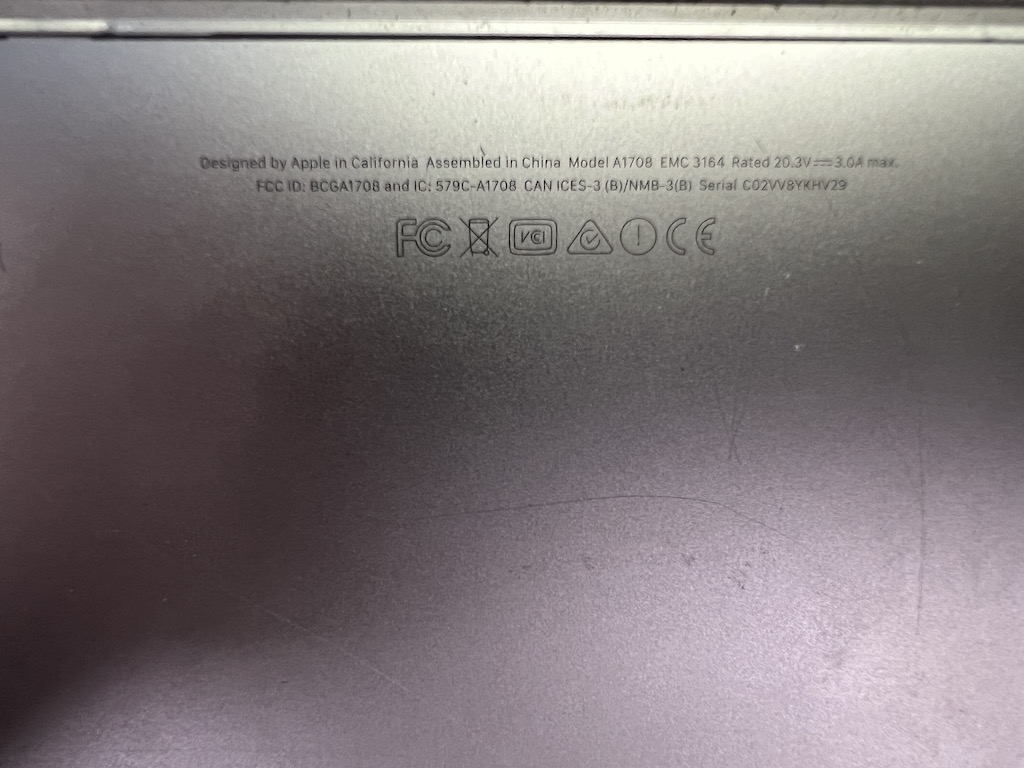
MacBook Pro Keyboard Replacement
Applied: Most model of Macbook Pro
How to identify it: At the bottom of your MacBook Pro there is engraved label – Start with A1708 (sample picture) and EMC3164
This mean : MacBook Pro 13″ Year 2017
Repair Duration : Within 1 business day

MacBook Pro Keyboard Replacement Description |
Price |
Model Name |
Also Known As – Model Identifier |
|
13 Inch MacBook Pro Unibody Year 2009-2012 |
$180 | A1278 EMC 2254 | MD101LL/A |
| 15 Inch Macbook Pro Unibody Keyboard Year 2009-2012 | $180 | A1286 EMC 2255 | MB470LL/A – MB471LL/A – MC026LL/A |
| 17 Inch MacBook Pro Year 2009-2011 | $200 | A1297 – EMC 2272 | MB604LL/A |
| 13 Inch MacBook Pro Year 2012 – 2015 Retina | $250 | A1502 EMC 2678 / EMC 2675 | ME866LL/A / MGX92LL/A / |
| 15 Inch Macbook Pro Year 2012 – 2015 Retina | $250 | A1398 EMC 2512 / EMC 2910 | MC975LL/A MJLU2LL/A* |
| 13 Inch MacBook Pro Year 2016 – 2017 | $375 | A1708 EMC 2978 | MLL42LL/A* |
| 13 Inch MacBook Pro Year 2016-2017 Keyboard (and touch bar) | $375 ($415) | A1706 EMC 3163 | MLH12LL/A* |
|
13 Inch Macbook Pro 2018-2020 Keyboard (and Touchbar) |
$400 ($450) | A1989, A2159, A2289, A2251, A2338 | |
|
15 Inch Macbook Pro 2016-2019 Keyboard (and Touchbar) |
$480 ($525) | A1707, A1990 | |
|
14 Inch Macbook Pro 2021 Keyboard (and Touchbar) |
$450 ($500) | A2442 EMC 3650 | MKGR3LL/A* |
|
16 Inch Macbook Pro 2019-2021 Keyboard + (and Touchbar) |
$480 ($520) | A2141, A2485 | |
MacBook Pro Keyboard Replacement
We Can supply you all type of Layout Keyboard – US Keyboard vs UK Keyboard vs Chinese Keyboard
How to Replace your MacBook Pro Keyboard in action
This great sample video show you how we do it
What Cause Macbook Pro Keyboard Damaged
There can be several reasons for MacBook Pro keyboard damage. Some common causes include:
- Dust and debris: Dust, food particles, or other debris can accumulate underneath the keys and cause them to become stuck or unresponsive.
- Liquid spills: Accidental spills of liquids such as water, coffee, or soda can damage the keyboard. When liquid enters the keyboard, it can cause the keys to become sticky or stop functioning altogether.
- Physical damage: Dropping or mishandling your MacBook Pro can result in physical damage to the keyboard, such as broken or loose keys.
- Wear and tear: Over time, the keyboard may wear out due to regular usage. Frequent typing can cause the keys to become less responsive or develop issues like double key presses.
- Manufacturing defects: In some cases, there may be manufacturing defects or design flaws that can lead to keyboard problems. Apple acknowledged issues with the butterfly keyboard mechanism used in earlier MacBook models, which resulted in a high failure rate and key reliability problems. They have since transitioned to the improved Magic Keyboard mechanism.
If you are experiencing keyboard issues with your MacBook Pro, it’s recommended to contact Apple Support or visit an authorized service center to diagnose and resolve the problem.
How to Fix MacBook Pro Keyboard
If you’re experiencing issues with your MacBook Pro keyboard, there are a few troubleshooting steps you can try to fix the problem:
-
Restart your MacBook: Sometimes, a simple restart can resolve temporary software glitches. Go to the Apple menu and select “Restart” to restart your MacBook.
-
Clean the keyboard: Dust, debris, or crumbs can cause keys to stick or become unresponsive. Shut down your MacBook, then use compressed air or a soft brush to clean around the keys. Be gentle to avoid causing any further damage.
-
Check for software updates: Ensure that your MacBook is running the latest version of macOS. Go to the Apple menu, select “System Preferences,” then choose “Software Update.” If updates are available, install them and see if it resolves the keyboard issue.
-
Reset the keyboard settings: Resetting the keyboard settings can sometimes help. Go to the Apple menu, select “System Preferences,” then choose “Keyboard.” Click on the “Keyboard” tab and click the “Restore Defaults” button. Alternatively, you can try unchecking and rechecking the options under “Keyboard” to see if it makes a difference.
-
Use an external keyboard: If the issue persists, you can connect an external keyboard to your MacBook and check if it functions properly. This can help determine if the problem is with the MacBook’s built-in keyboard or if it’s a software-related issue.
-
Contact Specialist Laptop Repairer: If none of the above steps resolve the issue, it’s best to reach out to Local Computer support or visit an authorized service center. They can provide further guidance or arrange for repairs if necessary.
It’s generally recommended to seek professional assistance if the issue persists or if you’re unsure about performing any repairs yourself.

